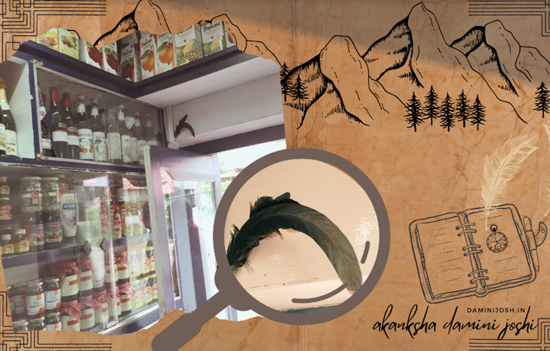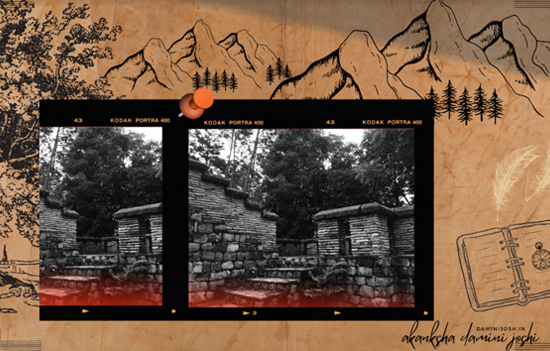- Pages off the filmmaker’s travel journal, reflecting on the unique interplay of modernity and tradition she witnessed in Shillong, Meghalaya.
Shillong, Meghalaya: It's a rainy day, like any other. My friend wants to buy some stuff for home. We walk into a grocery store in Laitumkhrah, the most buzzing market in Shillong. Not so far back in time, this hill town market was a typical away-from-river-side place. But deceptive is the nature of time. It crawls soft, in camouflage. Like Meghalaya's famous clouded leopard. It's disguise so fine, that it's invisible. Well, almost.
 Clouded Leopard.
Clouded Leopard.
We step into the grocery store. This could be
anywhere, really. Any Indian metro. Honey, Jams, Juices, Chocolates, Tropicana,
MTR, Cadburys, Dabur. Standard symbols of urban life these days.
But me? I am feeling restless. I can sense my eyes
searching, darting around. My nose, sniffing ... a story. Suddenly my eyes
freeze. They have found their destination. A smile begins to plays on my lips.
Right before my eyes is a symbol, a glimpse into a
world beyond the clever disguise of time. A key. To a time, not so long ago. A
key. To a language, never spoken in words, but whispered as songs. A time, a
language of ... Wonder.

My eyes are staring at the top of the entrance door. Two bird
feathers placed on the edge.
Meaningfully. An unknown something has gripped my attention.
Totally. Eyes twinkling with curiosity, I turn to the person at the counter, "What is that?!"
The young man at the counter is obviously shocked. It's not every other day that a woman - most certainly a stranger - walks in, demanding to know your secret symbolic communication with the world of the spirits!
His first lines, clear and simple, reveal the intricate weave of
time in the mindscape of these ancient peoples. He says, "I am a Christian. But I am also a Khasi."

Meet, Herbert Diengdoh, our gracious
shopkeeper-host who shares his story. About 15-20 years ago a terrifying
incident happened. In this very shop in Laitumkhrah, Herbert was robbed at gun
point.
After the incident, an intricate weave of time - both past and present, both tradition and modern - unfolded. Herbert took help. Not just from the modern, i.e., the state police. But also, simultaneously, tapped into his tradition's resources. He called a nongknia or nongduwai, a
traditional Khasi priest.
For Herbert, modernity and tradition were not
contradictory, they were complimentary. Each specialising in its own realm.
While the police tackled the case by listing out the suspects, following up on
clues. The Khasi priest suspected an evil spell.
The police and the nongknia, both
did what was needed in their vision. One in the material world, other in the
world of spirits. To ward off the evil spell, scared rituals were invoked. A
rooster was sacrificed. His two feathers with ritual prayers were placed on the
entrance, a protection against all evil.
Herbert explains it gracefully, "You see, like there is Feng-Shui, Vaastu, in the same way in Khasi culture ... this."
In the Khasi hills, belief in the world of the spirit goes deep. But modernity too has been embraced with style. Shillong is known as India's rock capital. It is one of the biggest educations hubs in northeast India. At the same time, the indigenous layer of myths, beliefs, culture, has not been rejected. In the Church announcements are still made of the food being 'safe', untouched by spells. People still believe in U-Thlen, the evil serpent who eats humans.
Much like in other ancient indigenous cultures of
India, it is a plus plus plus. Never a minus. Layers upon layers get added to
the original beliefs. The fundamental belief embellishes with time, but it is
never rejected.
 Roofs.
Roofs.
Watch this Khasi view of complementarity between
the ancient and the contemporary play out in one of the top most boutique
resorts of India, Ri Kynjai, featured in 2015 by Natgeo traveller
amongst the top Romantic getaways in India. The owner
architect is a wise Khasi elder, Prabhat Deb Sawyan. In the architecture
of this contemporary resort, has been crafted an ancient Khasi story. The roof
of each of the stunning luxury cottages is an upturned boat. Mesmerising, to
say the least.
Prabhat tells me when the ancestors of the Khasi's got to the hills from the sea, they turned their boat upside down and made it their first home. This indigenous story he has skilfully designed into his resort, revealing once again the complementarity with which the Khasi's view their present and past. The fundamental, stays. Quite literally.
 Foundation
Foundation
In Ri Kynjai, I notice a structure that
looks like it has a story to tell. Just foundations. Brick upon brick, lying
there. Nothing else. I enquire.
Prabhat had taken years to build a hut there. Then, one day, in one big whoosh, it all burnt. It could be the carpenter’s bidi, it could be the ... who knows. But the hut burnt down.
For years it's been lying like that. The old foundation - preserved, as is. The lessons, the learnings of the past. Prabhat never built on it again. You see, in the ancient land of the Khasi's, to build on the foundation of the old ... is a sang, a taboo. The older
foundation is to be preserved, as a learning.
The wise Khasi led me to a Khasi
creation story revealing this regard for the past in the Khasi NIYAM,
the religion. Sample it.
With the creation of the earth, were created sixteen families. They had a direct connect to heaven. They'd go up, come down by the means of a huge tree. But, as are the ways of life, man went astray. The huge tree, fell down. The families were sorry, they apologised. And then The Supreme Kindness, forgave and gave them ways to live life - NIAM, नीयम -
following which they could find the connect back to heaven.
Fall from heaven, and an ascent back to
that. Niam, religion: ways to get back. This Niam is encoded in small sutras,
keys. One fundamental sutra is: TIP KUR TIP KHA. Know and
respect your maternal and paternal kinship, in other words, know and respect
your roots.
In the Khasi view of human life on
earth, the attitudes we inculcate, the choices we make, are a key step in the ladder to back to heaven. The present warring against the past
leads to a future full of a vicious cycle of inner chaos, like our right hand
fighting the left.
The Khasi view is not of rejection, but of embrace. The past and the present. They are
not opposites, but complimentary. Not enemies, but friends.
Back in Herbert's shop, I smile a goodbye to the two feathers at the edge of the door. Herbert, as if catching my thoughts, grins back at me, "You know, education has given us the freedom to look back at our traditions. Earlier I just had to follow, now with this distance, I can take tradition as I want to, in a language of my world, my times.”
I walk out of the shop. Sense the modern
buzz of Laitumkhrah. And recognise. Beneath this buzz is
throbbing a tradition, that cannot be confined to past, present or future
- the deceptive categories of linear time. For this tradition is a flow. From
endless time, to endless time. Flowing, sometimes as a river and other times -
in this Land of Clouds, Meghalaya -
as a cloud raining into that river.
Author is an award winning documentary filmmaker,
cinematographer, writer, speaker and a meditation facilitator. Digital Image Art
and Photographs by the author. More on her at www.daminijosh.in
Also see
1. Vivekananda
Institute of Culture, Shillong
2. Ramakrishna
Mission School, Cherrapunji
3. Mawasmavi
Cave, Cherrapunji